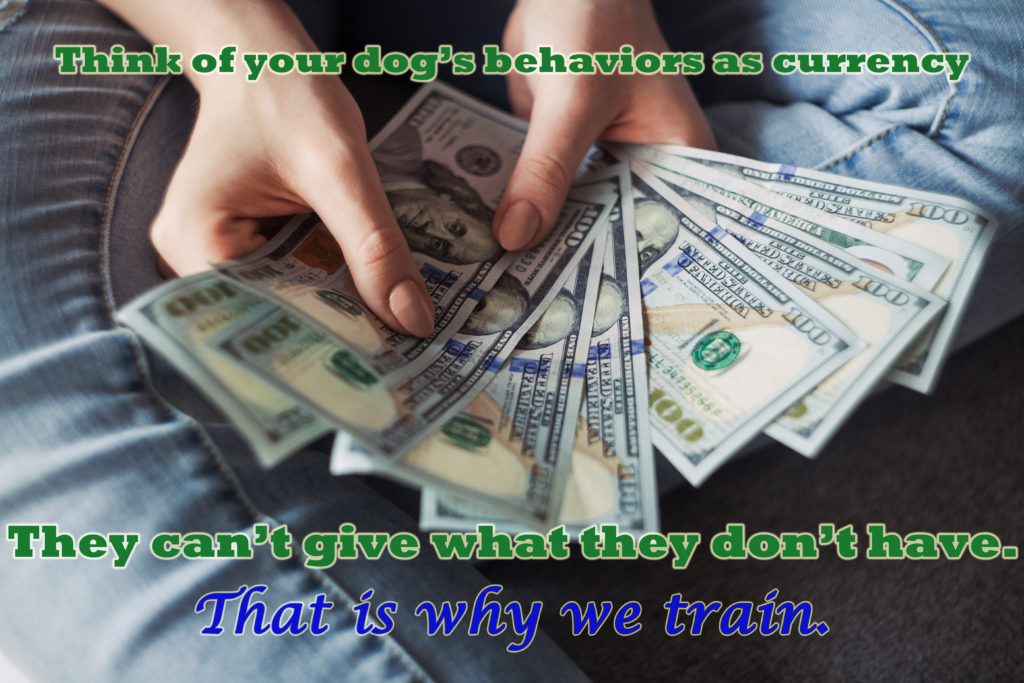Imagine for a moment that nobody ever showed you how to go to the store and buy things. Do you think it would have ever occurred to you to try to exchange green paper for things that you needed? More likely, you would have tried to offer things that were natural to you or that you found valuable, perhaps things like food or clothing. Paper money has no intrinsic value on its own, and therefore, until it can be exchanged for something that does hold some value to you, that green paper is meaningless.
Think of your pet’s behaviors the same way. When you first get a dog, for instance, they have no idea what they can do to trade for the things they want or need. They will likely try to “trade” using things that are natural to them, like barking and jumping. A cat will meow, a bird will squawk, etc.

Training is how we establish the bartering system your animal can use to “pay” for the things they want and need. Suddenly, a dog can “pay” for their dinner by sitting quietly while it is prepared, that sit having been established as a powerful currency.
The thing is, you can’t give what you don’t have.
If you want your pet to be able to offer you nice behaviors, you have to a) teach them b) reinforce them so they will be repeated and c) allow the animal to see that when they do repeat those behaviors, they can earn rewarding opportunities which create VALUE to the animal and establish that those behaviors are valuable to you. Ta-da! Now you have established currency. I will explain this more in a bit.
You may have heard someone say, “I make my dog work for everything. Nothing in life is free!” While that is taking things to the extreme end, it is my opinion that you do need to make your pets work for things, if for no other reason than to teach them the bartering system. Once your dog knows how to sit, it would be appropriate to ask them for that before you put on their leash, before you feed them, before you open the door to the back yard, etc. In this way, you are teaching them that the behavior of sitting has value and can, quite literally as it turns out, open doors.
It is totally unreasonable to think that your pets are born knowing this barter system. So often I hear people say, “but he knows what I want! He’s just being stubborn!” I disagree. Your dog may know how to sit, but if you’ve never shown him the power of that sit in this context, he probably doesn’t know what you want at all! In this context, that sit has not been established as valuable currency. You have more work to do.
So how can we make sure we create a valuable currency of behaviors?
Teach lots of behaviors that are valuable to you!
You want to fill up your dog’s behavior wallet full of valuable currency they can use down the road. Some of my favorites:
- Sit
- Down
- Eye contact
- Wait
Reinforce those behaviors heavily so that your pet will repeat them.
Reward nearly every valuable behavior you see. Reward it in nearly every context you see it, whether you’ve asked for it or not. Make a mental note of when and where it is being offered. If you aren’t seeing it in certain places (for example, your dog offers a sit outside but never a down), ask for it and reward it in that context so that your pet learns that this behavior has value in that location as well.
*Note that rewards are in the eye of the recipient! If you aren’t seeing behavior increase after reinforcement, you aren’t rewarding it! See my article on Rewards are for Always for more on what is, and isn’t, a reward.
Allow the animal to see that these behaviors are valuable currency.
This is where you begin rewarding these behaviors with “real life” rewards like opening doors, play, meals, etc. This is taking that training outside the training session and into real life. When your dog isn’t offering a behavior, ask for the one you want in the same way that a shopkeeper might tell a customer, “this is $25.”
Don’t forget to sometimes let your animal put in the opening bid! It’s ok to occasionally stand by with your hand on the leash or the door handle and wait to see what your dog offers you. This helps them to learn that THEY can control the outcome of a situation by offering YOU a particular “payment.” Be sure to reward them with the things they request if they’ve offered you an appropriate behavior. Maybe it wasn’t the behavior you expected, but perhaps it is just as nice or better!
Bottom line:
You need to remember; they can’t give you what they don’t have! One of the best things you can do is take a training class with your dog to help make sure all your foundation behaviors (sit, down, attention/eye contact, etc) are firmly understood by your dog in a variety of locations with varying levels of distractions. If you haven’t trained it, rewarded it, and established value in a given context, they may not be able to give you that behavior even if they’ve offered it in other situations. A certified, professional trainer can help guide you to perfecting your dog’s behavior currency!
Happy Training!
Nicole L Yuhas CPDT-KA
This blog is intended to be informative as well as entertaining. It contains my opinion which may not reflect the opinions of any organization I may be affiliated with. My opinions should not be interpreted as those of my coworkers, family, friends, casual acquaintances, and certainly not the opinion of my cat, although my dog probably agrees with everything I say, if for no other reason, than because I provide the treats and meals (cats are less inclined to agree with anyone but themselves). Information provided here is accurate and true to the best of my knowledge but, as information and opinions change, neither the facts nor the opinions expressed here may be true or accurate at any future date. As I don’t currently own a time machine, I cannot be responsible for things that prove to be untrue, or opinions I change my mind about, should those changes become apparent in the future. It should also be noted that, as I am human, there may be omissions, errors or mistakes in the information provided here. Frankly, even if I were a computer, it is likely there would be errors, as computers, in my experience, can be a royal pain in the butt. This blog may contain affiliate links which you are under no obligation to click. If you click them, they will hopefully take you the place I intended. But they may not. As I’ve said, computers can be a pain. If you find yourself somewhere you don’t think I intended, click your ruby slippers three times together and say, “there is no place like home.” If you do that, and click the “back” button, you should be safely returned. Computers can, at times, have a mind of their own. Any training suggestions or opinions expressed here should be taken as information only and should not be seen as advice particular to you or your dog’s unique situation. Please consult with a training professional before taking any action.
